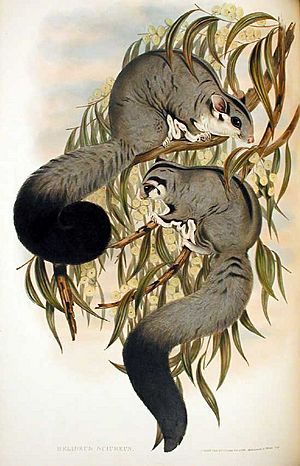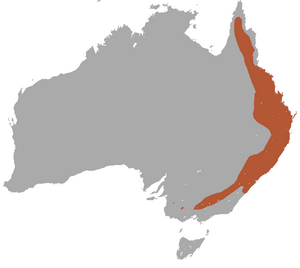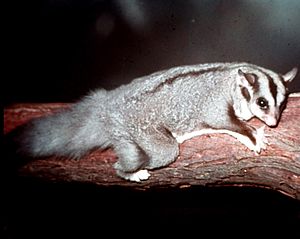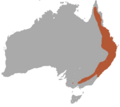Squirrel glider facts for kids
Quick facts for kids Squirrel glider |
|
|---|---|
 |
|
| Conservation status | |
| Scientific classification | |
| Genus: |
Petaurus
|
| Species: |
norfolcensis
|
 |
|
| distribution | |
The squirrel glider (Petaurus norfolcensis) is a fascinating animal that is active at night, meaning it is nocturnal. It's a type of gliding possum and belongs to a group called wrist-winged gliders. These amazing creatures are known for their ability to glide through the air.
Contents
Where Do Squirrel Gliders Live?
Squirrel gliders are found in Australia. Their home stretches from Bordertown in South Australia, across Victoria, and up into northern Queensland. For a long time, people thought they had disappeared from South Australia after 1939. But a genetic test later proved they were still living there!
These gliders prefer to live in dry eucalypt forests and woodlands in south-eastern Australia. However, in Queensland, they can also be found in wetter eucalypt forests. They make their homes, called dens, inside hollow trees and line them with leaves. Squirrel gliders often live in small groups, usually with one male, two females, and their young.
What Does a Squirrel Glider Look Like?
Like many wrist-winged gliders, the squirrel glider is only found in Australia. It's about twice the size of its cousin, the sugar glider. A squirrel glider's body is typically 18–23 centimeters (about 7-9 inches) long, and its tail can be even longer, measuring 22–33 centimeters (about 9-13 inches). They weigh around 230 grams (about half a pound).
They have soft fur that is blue-grey or brown-grey on their backs and white on their bellies. The tip of their tail is black, and they have a distinct black stripe that runs from their eyes all the way down their back.
One of their most special features is a stretchy skin membrane called a patagium. This membrane extends from their fifth front toe to the back of their foot on both sides of their body. When they spread their limbs, this membrane acts like a parachute, allowing them to glide. Their long, bushy tail helps them steer as they glide, like a rudder on a boat. They can glide impressive distances, up to 50 meters (about 164 feet), from one tree to another!
Squirrel Glider Reproduction and Life Cycle
Squirrel gliders usually breed between June and January. After a female becomes pregnant, her gestation period (pregnancy) lasts about 18 days. Typically, one or two babies are born at a time.
When a baby squirrel glider is born, it's very tiny. It immediately crawls into its mother's pouch and attaches itself to a teat. It stays safely in the pouch for about three months, drinking milk and growing. The mother starts to wean her offspring (stop feeding them milk) around four months old, but they will stay in the den. Young gliders become independent and leave their parents when they are about 10 months old. Squirrel gliders usually live for 4 to 6 years.
What Do Squirrel Gliders Eat?
Squirrel gliders enjoy a varied diet. They mostly eat fruit and insects. They also love to feed on tree sap, especially from eucalyptus or red bloodwood trees. To get the sap, a squirrel glider will make a small hole in the tree trunk, causing the sap to flow out. Besides sap, they also eat pollen, nectar, leaves, and even tree bark.
What Threats Do Squirrel Gliders Face?
Squirrel gliders have natural enemies like owls. However, they also face threats from animals that humans have brought to Australia, such as dogs, cats, and foxes.
Another big problem for squirrel gliders is habitat fragmentation and destruction. This happens when human activities, like building or clearing land, break up their forest homes into smaller, isolated pieces. This makes it harder for gliders to find food, mates, and safe places to live.
Even with these threats, the squirrel glider population is currently quite large, and they live in several protected areas. Because of this, the International Union for Conservation of Nature (IUCN) lists them as a species of "Least Concern," meaning they are not yet considered threatened.
Squirrel Gliders and Flying Squirrels
Squirrel gliders are sometimes confused with flying squirrels, which live in North America. However, these two animals are not closely related at all! Squirrel gliders are marsupials, like koalas and kangaroos, meaning their babies develop in a pouch. Flying squirrels, on the other hand, are placental mammals, which means their babies develop inside the mother's body.
Despite being different types of animals, both squirrel gliders and flying squirrels have a special adaptation for living in trees: the patagium. This is the skin membrane that stretches between their front and back legs, allowing them to glide between trees. This helps them avoid predators they might encounter on the ground. Because these animals are so distantly related but developed similar features to help them survive, we call these characteristics analogous structures.
Images for kids
See also
 In Spanish: Ardilla planeadora para niños
In Spanish: Ardilla planeadora para niños




